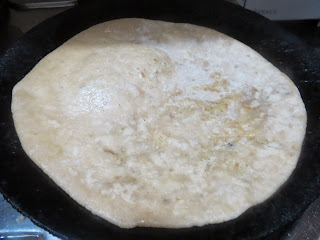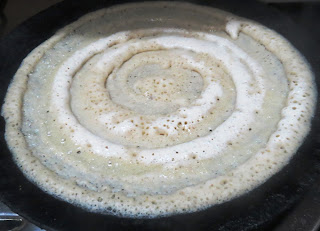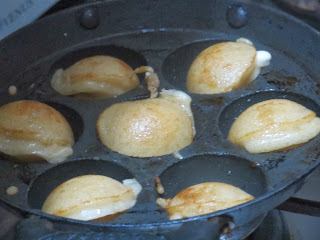Almond ( Badami in Kannada ) + Besan (Kadale Hittu in Kannada language) Wheat Holige is a sweet dish and you can enjoy these holiges (pooran Poli) at any time of the day and all age group will surely like it.
Normally Holige is done with Maida. Here I have used wheat flour.
Eating Almonds yield many benifits like they reduce heart attack risk. They lower the bad cholesterol. They protect artery walls from damage. Almonds help build strong bones and teeth. They provide healthy fats. They nourish the nervous system. They help provide good brain function. Using almonds have many more benifits.
Besan is naturally higher in protein, Contain good amount of vitamins and minerals and it is gluten free.
Wheat flour contains vitamins, protein and fiber.
Almond Besan Wheat Holige stuffing is prepared using milk, sugar, almonds,besan and cardamom.
Outer layer dough is prepared with wheat flour instead of maida.
Almond + besan Holige can be had for lunch during festivals and also you can have them for evening snack. You can also pack them for your kid's lunch-box as snack for the school going kids.
Milk :1 cups
Sugar : 1 1/2 cups
Almonds : 1 Cup
Besan : 2 Table spoons
Coconut : 1/2 cup
Cardamom : 6 to 8 pods
For the outer layer
Things Needed :
Wheat flour : 2 Cups
Water : required
Salt : a pinch
Oil : 1 Cup
Method :
For stuffing : Sweet mixture: (Hoorana)
1. Powder cardamom and Almonds, dry grind coconut and keep it aside.
2. Boil Milk and add sugar to it.
3. Add Almond powder to the milk and mix it well.
4. Keep stirring. Add dry ground coconut and besan to the mixture.
5. Stir continuously till it stars to leave the pan. Add a spoon of ghee.
6. Now remove the mixture and put it in a bowl. Let it cool.
7. Mix the mixture nicely when it cools and keep it aside.
Chapati dough ( The outer layer ) :
1. Take a bowl and put wheat flour and salt. Put required water and prepare chapati dough.
Now Almond + Besan wheat Holige.
1. Knead the chapati dough and divide them into small portion. (little bigger than lemon size).
2. Keep a small portion of dry wheat flour in a small bowl.
3. Take a small ball and roll out to small papad size.
4. Keep a tablespoon of sweet mixture and cover the chapati from all side and bring it ball shape.
( like aloo stuffing).
5 Now take that sweet mixture ball and roll a little on dry wheat flour and roll like a chapati.
6 Keep a pan on the fire and heat. Sprinkle little oil on the pan.
7 Now put the sweet chapati on the pan and cook on both sides. Use little oil on both sides.
8 Repeat the same with remaining dough.
9. Serve Hot Amond + Besan Wheat Holige with a teaspoon of ghee on the top.
Note : Do the whole process of sweet mixture on low flame. If you feel the mixture is still liquidy use little more besan and mix it nicely. No need to add more ghee or oil to it. Once the mixture is cooled it thickens. You can reduce or add the amount of the sugar as your wish.
Serves : 3 to 4
Time : 40 min.
Normally Holige is done with Maida. Here I have used wheat flour.
Eating Almonds yield many benifits like they reduce heart attack risk. They lower the bad cholesterol. They protect artery walls from damage. Almonds help build strong bones and teeth. They provide healthy fats. They nourish the nervous system. They help provide good brain function. Using almonds have many more benifits.
Besan is naturally higher in protein, Contain good amount of vitamins and minerals and it is gluten free.
Wheat flour contains vitamins, protein and fiber.
Almond Besan Wheat Holige stuffing is prepared using milk, sugar, almonds,besan and cardamom.
Outer layer dough is prepared with wheat flour instead of maida.
Almond + besan Holige can be had for lunch during festivals and also you can have them for evening snack. You can also pack them for your kid's lunch-box as snack for the school going kids.
Things Needed :
For the stuffingMilk :1 cups
Sugar : 1 1/2 cups
Almonds : 1 Cup
Besan : 2 Table spoons
Coconut : 1/2 cup
Cardamom : 6 to 8 pods
For the outer layer
Things Needed :
Wheat flour : 2 Cups
Water : required
Salt : a pinch
Oil : 1 Cup
Method :
For stuffing : Sweet mixture: (Hoorana)
1. Powder cardamom and Almonds, dry grind coconut and keep it aside.
2. Boil Milk and add sugar to it.
3. Add Almond powder to the milk and mix it well.
4. Keep stirring. Add dry ground coconut and besan to the mixture.
5. Stir continuously till it stars to leave the pan. Add a spoon of ghee.
6. Now remove the mixture and put it in a bowl. Let it cool.
7. Mix the mixture nicely when it cools and keep it aside.
Chapati dough ( The outer layer ) :
1. Take a bowl and put wheat flour and salt. Put required water and prepare chapati dough.
Now Almond + Besan wheat Holige.
1. Knead the chapati dough and divide them into small portion. (little bigger than lemon size).
2. Keep a small portion of dry wheat flour in a small bowl.
3. Take a small ball and roll out to small papad size.
4. Keep a tablespoon of sweet mixture and cover the chapati from all side and bring it ball shape.
( like aloo stuffing).
5 Now take that sweet mixture ball and roll a little on dry wheat flour and roll like a chapati.
6 Keep a pan on the fire and heat. Sprinkle little oil on the pan.
7 Now put the sweet chapati on the pan and cook on both sides. Use little oil on both sides.
8 Repeat the same with remaining dough.
9. Serve Hot Amond + Besan Wheat Holige with a teaspoon of ghee on the top.
Note : Do the whole process of sweet mixture on low flame. If you feel the mixture is still liquidy use little more besan and mix it nicely. No need to add more ghee or oil to it. Once the mixture is cooled it thickens. You can reduce or add the amount of the sugar as your wish.
Serves : 3 to 4
Time : 40 min.














































